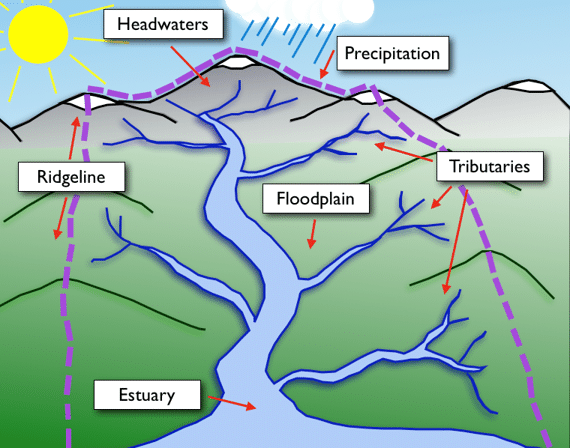Watershed Planning
What is a Watershed?

A watershed is an area of land that drains all the water—whether from rain, snowmelt, or other sources—into a common water body such as a river, stream, lake, or ocean. Watersheds are defined by topography. Watershed boundaries are the high points or ridges on the landscape, where water flows down in different directions. Watersheds can be identified on different scales. For example, Lake County is located in the Lake Erie watershed as well as the Atlantic Ocean watershed. Any water that drains within the County will end up in Lake Erie and eventually flow into the Atlantic Ocean.
All bodies of water are directly influenced by the characteristics of their watersheds. The land use within the watershed affects the quality of water flowing into the body of water. Activities such as urbanization, agriculture, and deforestation can increase runoff volumes and pollutants that negatively impact water quality. Forests, grasslands, and wetlands can retain water, absorb pollutants, and reduce the volume of runoff to minimizing flooding.
A healthy watershed supports diverse ecosystems. Polluted or altered watersheds can disrupt aquatic and terrestrial habitats, affecting fish populations, plant growth, and biodiversity in general. Overall, the health of a watershed is directly linked to the health of the water bodies it feeds.
Watershed Planning

Watershed planning is the process of developing strategies and actions to manage and protect water resources within a watershed. It involves assessing the current conditions of the watershed, identifying problems (such as pollution, flooding, erosion), and implementing solutions that promote sustainable land and water use. Watershed planning takes a holistic, integrated approach by considering the entire area that drains into a common water body, rather than focusing on individual sites or issues in isolation.
Benefits of Watershed Planning:
- Improved Water Quality: By managing land use and reducing pollution sources, watershed planning helps protect drinking water sources and improve overall water quality.
- Flood Control: Proper watershed management helps mitigate flooding by enhancing natural water retention through wetlands, forests, and other green infrastructure.
- Ecosystem Restoration: Watershed planning supports the restoration of aquatic and terrestrial habitats, benefiting wildlife and biodiversity.
- Sustainable Development: Encourages development practices that are in harmony with natural water cycles and ecosystems.
- Public Education and Outreach: Raises awareness among local communities and stakeholders about the importance of watershed health and how they can contribute to its protection.
Nonpoint Source Implementation Strategies (NPS-IS)
As part of their watershed planning efforts, Lake SWCD develops NPS-IS plans to guide project implementation. The 9-Element NPS-IS is a strategic plan used to show nonpoint source grant programs that a proposed water quality project follows the 9 essential guidelines set by the U.S. EPA. For more information please visit the Ohio Nonpoint Source Pollution Control Program on the Ohio Environmental Protection Agency website.
For a project to qualify for certain funding opportunities, like the Ohio EPA Section 319 Funding, it must be included in a U.S. EPA-approved 9-Element NPS-IS plan for the specific watershed area (HUC-12) where the project is located.
The NPS-IS ensures funded projects:
- Are based on the best available science.
- Target the areas with the most serious issues.
- Include management, evaluation, and educational components to maximize long-term benefits to the water resource.
The NPS-IS is a flexible document that outlines the causes of water issues, identifies critical areas, sets measurable goals, and describes projects aimed at fixing those issues. Each plan is unique to its watershed and is updated over time with new projects, data, and objectives, requiring approval from Ohio EPA for any changes.
Lake SWCD has developed NPS-IS plans for nine HUC-12 watersheds in Lake County.

